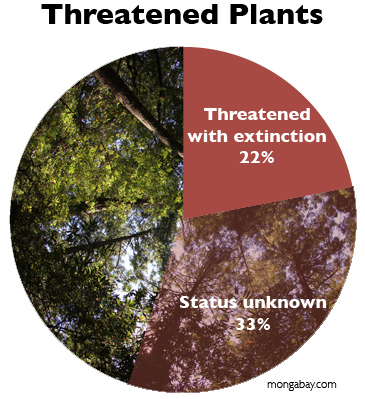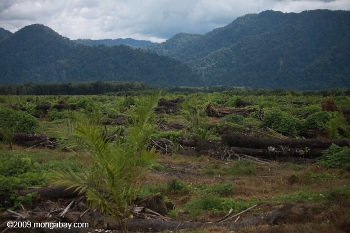Scientific warnings that the world is in the midst of a mass extinction were bolstered today by the release of a new study that shows just over a fifth of the world’s known plants are threatened with extinction—levels comparable to the Earth’s mammals and greater than birds. Conducted by the Royal Botanic Gardens, Kew; the Natural History Museum, London; and the International Union for the Conservation of Nature (IUCN), the study is the first time researchers have outlined the full threat level to the world’s plant species. In order to estimate overall threat levels, researchers created a Sampled Red List Index for Plants, analyzing 7,000 representative species, including both common and rare plants.
“This study confirms what we already suspected, that plants are under threat and the main cause is human induced habitat loss,” Stephen Hopper, the director of the Royal Botanic Gardens, Kew, said in a statement. “In order to answer crucial questions like how fast are we losing species and why, and what we can do about it, we need to establish a baseline so that we have something against which to measure change. The Sampled Red List Index for Plants does exactly that by assessing a large sample of plant species that are collectively representative of all the world’s plants.”
 |
Not surprisingly, the researchers uncovered that tropical plants were the most threatened with tropical rainforests making up the most endangered habitat. Of the world’s plant groups, conifers and cycads which make up the gymnosperms, were the most endangered. Habitat loss, driven largely by agriculture and livestock, proved to be the gravest threat to the world’s plant species.
The list, coordinated by the Institute of Zoology at the Zoological Society of London (ZSL), is in direct response to the United Nations International Year of Biodiversity and the 2010 Biodiversity Target, which presented a goal to stem the loss of biodiversity by this year. However, officials freely admit that nations failed on this goal. Nations are set to meet in mid-October in Naguya, Japan to discuss what comes next. Nearly all of the world’s nations are behind the treaty expect one notable absentee: the US has signed the treaty, but failed to ratify it in congress.
“The 2020 biodiversity target that will be discussed in Nagoya is ambitious, but in a time of increasing loss
of biodiversity it is entirely appropriate to scale up our efforts. […] We cannot sit back and watch plant species disappear—plants are the basis of all life on earth, providing clean air, water, food and fuel,” Hopper added. In prioritizing endangered species, plants have often been overshadowed by more ‘popular’ charismatic birds and mammals, yet ecologically plants underpin the world’s ecosystems.
Plants have also provided humanity with many life-saving medicines including quinine, aspirin, morphine, as well as cancer and HIV-fighting drugs. Despite such discoveries the vast majority of plants remain untested for possible medicinal benefits: a study in 1996 found that less than one percent of plants in tropical rainforests had been screened. Many may already be lost to extinction.
In addition to finding that approximately 20 percent of the world’s plants are threatened with extinction, the study also determined that scientists know too little about 33 percent of the world’s plants to even make an assessment of their threat level.
 Palm oil plantation in Indonesia with forest in the background: habitat loss is the primary cause of the world’s endangered plant species. Photo by: Rhett A. Butler. |
“The work in this report took us several years to complete and is based on very careful assessments of thousands of species worldwide by hundreds of scientists. For the first time we have reliable data on which types of plants are most threatened, where and why. It would not have been possible without modern developments in computers and satellite imagery: anyone can see the extent of habitat conversion with Google Earth, but our report relates this to the status of individual species all over the world and clearly shows the depth of the biodiversity crisis we face,” says Dr. Neil Brummitt, head of the Sampled Red List Index for Plants at the Natural History Museum, London.
No one knows how many plant species exist in the world as every year brings to light new species (2,080 new plants were discovered in 2008 alone). Yet experts estimate that plant species probably number around 380,000. In contrast scientists have described 5,490 mammals, which are far better known than plants.
The world’s extinction rate is currently estimated at 100 to 1,000 times higher than the background extinction rate (i.e. average extinction rate as determined by studying fossils), leading them to warn of a mass extinction that could rival the comet which destroyed the dinosaurs.
Citation: Brummitt, Neil et al. (2010) Sampled Red List Index for Plants. Royal Botanic Gardens, Kew; Institute of Zoology, Zoological Society of London; International Union for the Conservation of Nature and Natural Resources (IUCN).
Related articles
Collapsing biodiversity is a ‘wake-up call for humanity’
(05/10/2010) A joint report released today by the Convention on Biological Diversity (CBD) and the UN Environment Program (UNEP) finds that our natural support systems are on the verge of collapsing unless radical changes are made to preserve the world’s biodiversity. Executive Secretary of the Convention on Biological Diversity, Ahmed Djoghlaf, called the bleak report “a wake-up call for humanity.”
Saving biodiversity ‘on the same scale’ as climate change: German Chancellor
(01/11/2010) In a kick-off event for the UN’s Year of Biodiversity, German Chancellor Angela Merkel, compared the importance of saving biodiversity to stopping climate change.
Alleviating poverty and saving biodiversity are inherently linked argue scientists

(09/17/2009) Twenty-nine scientists argue in Science today that the world will not be able to lift up the world’s poor unless it also addresses global biodiversity loss. They say that the same underlying problems—exploitation of resources, unsustainable overconsumption, climate change, population growth—are exacerbating global poverty and the extinction of species.
Amphibians face mass extinction
(08/11/2008) Amphibians are in big trouble. At least one third of the world’s 6,300 known species are threatened with extinction, while at least 200 species have gone extinct over the past 20 years. Worryingly the outbreak of a deadly fungal disease, chytridiomycosis, is spreading throughout the tropics leaving millions of victims. A new study, published in the early edition of the Proceedings of the National Academy of Sciences, warns that there is “little time to stave off a potential mass extinction” of frogs, salamanders, and caecilians.
7 steps to solve the global biodiversity crisis
(08/11/2008) Many biologists believe Earth is entering a sixth mass extinction event, one that has is the direct of human activities, including over-exploitation, habitat destruction and introduction of alien species and pathogens. Climate change — largely driven by anthropogenic forces — is expected to soon increase pressure on Earth’s biodiversity. With population and per-capita consumption expected to grow significantly by the mid 21st century, there seems little hope that species loss can be slowed. Nevertheless, writing in the journal PNAS, Stanford biologists Paul R. Ehrlich and Robert M. Pringle suggest seven steps to help improve the outlook for the multitude of species that share our planet.